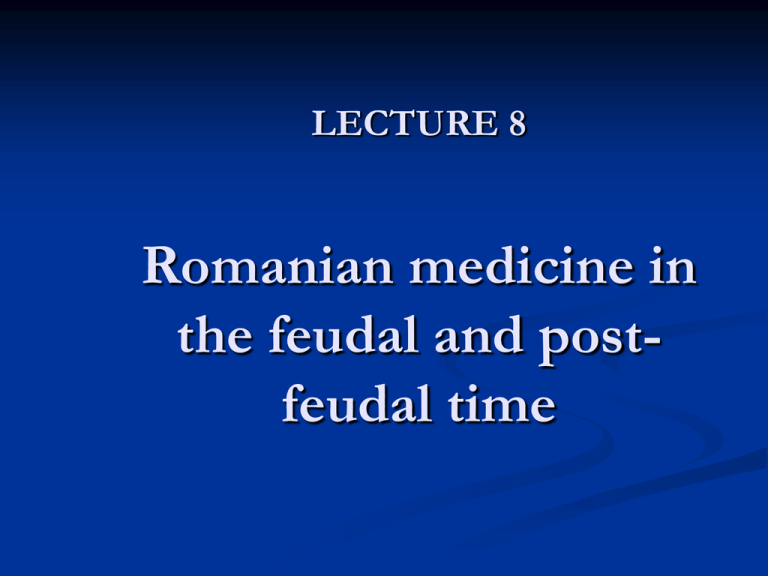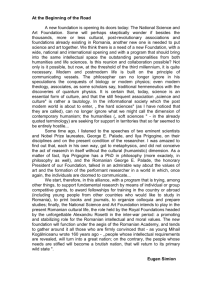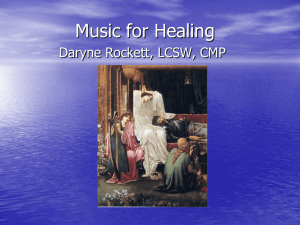History of Medicine Lecture 8
advertisement

LECTURE 8 Romanian medicine in the feudal and postfeudal time The mythological figure of Zamolxis Healing art traditions of the Romanian people Romanian medicine in the feudal and post-feudal time The mythological figure of Zamolxis The period in which Zamolxe lived is uncertain. Herodotus considered him as a slave of Pythagoras (580-500B.C.) who later won his freedom. this God was primarily a civilizing Geto-Dacian population He taught those people to believe in immortality, practice abstinence and respect justice He also introduced a series of magical-medicinal practices. to persuade the Thracians to believe in his teaching about immortality, he commanded to build an underground house where he stayed closed for 3 years. The Thracians believed that he was dead, but at the beginning of the fourth year it has come to light. Romanian medicine in the feudal and post-feudal time It is believed that Zamolxis lived near Pytagora and there are many similarities between the two doctrine the most famous example is the theory of immortality or metempsychosis Zamolxis’s disciples were ascetic, contemplative and vegetarians and Pythagoras's led a simple life, being too modest and also vegetarians Zamolxis’s a followers were known as doctors. Zamolxis’s medice was doubled by his magical practice remedies for diseases were accompanied by spells: medicine healed the body and the spell cured the soul. many archaeological discoveries confirm the surgical skills of the Dacians The trepanation practice is proved by the skulls found in CRISTESTI interventions on the frontal and parietal regions were common Romanian medicine in the feudal and post-feudal time Healing art traditions of the Romanian people healing art from the Romanian people is a millenary tradition, that can be considered an ancestor gift climatic conditions of Dacia, correlated with geographic richness in this region favored the existence of an incredible diversity of plant species Ever since the Dacians, a number of plants that grow on Romania's territory was used as herbs for cure reputation of some of the plants went so far as they appear today in popular perception as being endowed with magical healing virtues related to a plant mythology many plants are considered sacred, such as basil, some making once the subject of a specific denomination, Mandrake, whose name combined the two words Vedic matra and guna. Romanian medicine in the feudal and post-feudal time plants of great biological importance to man through their active principles are common where once were Dacians settlements. Not by chance in these areas grow flowers such as Banuteii (Bellis perenis), used against chronic bronchitis, Saschiul (Vinca minor), Banat (Geranium) used in folk practice against aches. In Moldova over the Prut peasants used to administer medicine plants with magical practices. according to a popular belief the knowledge of the therapeutic virtues of plants can be acquired directly from them through the mythical white snake. in the first half of the 19th century in Transylvania was known the wizard Michael Sas who said that a magic snake gave him the knowledge of speaking to the healing herbs. Romanian medicine in the feudal and post-feudal time miraculous plant collection unfolds like a cosmic timetable followed a specific ritual. Some plants such as garlic or wormwood retains its healing virtues throughout the year other plants, were collected before Pentecost because they were losing their beneficial power for a month afterwards. The drying of plants is made in the bunch that hangs about a beam in the attic Here are some plants together with their healing virtues: rheumatic pains: Coada racului (Potentilla anserinna) and Buruiana junghiului (Stellaria graminea) Typhoid: Drob (Cytisus Heufelianus) breast disease: Turita mare (Agrimonia eupatorium), Lytosperumum arvense Romanian medicine in the feudal and post-feudal time Hepatitis: Buruiana galbinarii (Potentilla recta), Carrot (Daucus carota) Stomach ache: Volbura (Convulvulus arvensis), Brustan (Telechia speciosa) Hernia: Studenita (Arenaria serpillyfolia), Sanziene (Galium mollugo) The first pharmacies in the Middle Ages • • • • • in the Middle Ages there were set up the first urban pharmacies supported by the mayors of Sibiu (1494), Brasov (1512), Bistrita (1516) and Fagaras. they were delivering extracts, syrups and herbal essential oils in the late of the 16th century medicinal plants for treatment were known as species and were distributed by the pharmacist. the first hospital in the country to use local medicinal plants were built near the monastery Coltea in Bucharest between 1695-1708. The hospital had 24 beds for poor patients who were treated with various herbal healing. during the reign of Grigore III Ghica of Moldavia, is founded Saint Spiridon hospital of Iasi (1757). in this hospital the treatment for all diseases combined the use of plant medicine with prayer for healing suffering. the needs of plants were provided by Anton Faermann pharmacist, with his entire family died during the plague of 1770. another religious place used in healing the sick with the help of curing plants was Obedeanu Monastery in which the Craiova hospital was founded in 1777.











